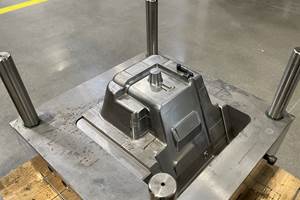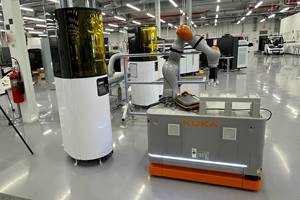Automotive Tech Center Sees Benefits and Challenges of AM
The Nissan Technical Center leads Nissan’s work with additive manufacturing. While it has found uses for AM, it maintains a cautious approach to what the technology can currently accomplish.
Share

What a difference generative design and metal 3D printing can make: an organic bracket produced by Nissan made of 316L stainless steel. Photo Credit: Nissan
The Nissan Technical Center is a leading user of additive manufacturing in the automotive industry, although as yet it uses AM as a secondary process. Nilesh Dale, senior manager, Advanced Materials and Technology Research, at the Nissan Technical Center North America in Farmington Hills, MI, makes an interesting point about AM’s status in the automotive industry when asked what nomenclature is used: “We normally call it ‘3D printing,’” he says, explaining, “that is most commonly accepted by the general public, including those who are not familiar with the technology at all.”
This is actually a major roadblock when talking about AM between organizations: Too often, people who are deep into the technology have the idea that others are similarly engaged. Consequently, not only could there be a lack of communication, but miscommunications could occur unless there is a shared understanding. Dale says Nissan has found that “general acceptance of the technology to the majority of traditional CAD designer/engineers, prototyping engineers and technicians is still very low.” In short, defining terms before discussing technology is often necessary when talking about the AM field.
Technology
Although 3D printing is a mature technology in some ways (having been around since the mid-1980s), it is currently undergoing a burgeoning number of new developments that introduce more uncertainty than longer-established processes like milling. Utilizing it forces the Nissan Technical Center to balance two key considerations: working with leading companies that have established equipment and processes is important for auto, because quality and reliability are exceedingly important — but working with emerging companies is important in general, because they are on the cutting edge of producing additively, and having early exposure to new additive technology can be highly beneficial.
As a result, Dale says the Nissan Technical Center partners with both types of companies, “partnering with almost all leading 3D printing companies to leverage their expertise and technology. We use and test almost all types of 3D printing processes, including FDM, SLA, SLS, binder jetting and new, emerging 3D printing technologies.”
What’s in Production?
Despite the wide array of partners, production AM is not an option yet for the Nissan Technical Center. “Most parts for Nissan assembly lines require high-volume production, and current 3D printing speeds prohibit it,” Dale says. But while AM may not currently make parts swiftly enough for production, “we are identifying low-volume production parts, heritage parts, after-market parts and complex assembly parts to consolidate in a single assembly by 3D printing.” Parts such as these “can be near-future applications using 3D printing.”
In the meantime, Dale says Nissan is using AM for “jigs and fixtures, simple brackets, small tooling and replacement parts.”
Positives and Negatives
Dale is quick to point out the advantages of 3D printing for Nissan. “In addition to quick prototyping, the main benefit we have seen is actually the combination of two technologies: generative design and 3D printing, which offer lightweighting,” he says, citing the use of new metal alloys, metal-matrix composites and lattice structural design. He also points to performance improvements with impact resistance and mechanical and thermal fatigue resistance, as well as part consolidation and manufacturing simplification from less assembly, joining, bonding and welding.
These improvements do come with some caveats, like the already-mentioned speed issues. Size has proven to be a problem, with Dale noting that “automotive components, both metal and plastics, are generally too big to fit into current commercial 3D printers.” He also says that repeatability and reproducibility are not up to the same level as established manufacturing. Print quality provides one additional issue, with Dale saying quality parameters, “such as surface finish, internal porosity and so on, still do not meet automotive industry standards, even for low-volume production.”
Solving these issues will be important for shaping the future of automotive production, but even the act of solving them requires dealing with the issue of cost. Dale himself says “high material cost and relatively low throughput are limiting the adoption for now.”
Related Content
8 Cool Parts From RAPID+TCT 2022: The Cool Parts Show #46
AM parts for applications from automotive to aircraft to furniture, in materials including ceramic, foam, metal and copper-coated polymer.
Read MoreDaimler, OMIC Evaluate Wire-Fed DED for Moldmaking
3D printing a core and cavity on machine from Gefertec, followed by machining, allowed for a complete mold tool to be produced in three days.
Read More3D Printed Cold Plate for an Electric Race Car: The Cool Parts Show #51
An unconventional lattice design and biomimicry are key to the performance of this fluid-cooled heat exchanger for a battery-powered race car.
Read MoreAutonomous Cobot Automation Increases Production 3D Printer Output for Ford (Includes Video)
A mobile robot that travels to each Carbon machine to unload builds lets the automaker run an additional three to four builds per machine per day. Autonomous robots fit well with 3D printing, but their role in production will extend beyond just the additive machines.
Read MoreRead Next
3D Printing Brings Sustainability, Accessibility to Glass Manufacturing
Australian startup Maple Glass Printing has developed a process for extruding glass into artwork, lab implements and architectural elements. Along the way, the company has also found more efficient ways of recycling this material.
Read More4 Ways the Education and Training Challenge Is Different for Additive Manufacturing
The advance of additive manufacturing means we need more professionals educated in AM technology.
Read MoreAt General Atomics, Do Unmanned Aerial Systems Reveal the Future of Aircraft Manufacturing?
The maker of the Predator and SkyGuardian remote aircraft can implement additive manufacturing more rapidly and widely than the makers of other types of planes. The role of 3D printing in current and future UAS components hints at how far AM can go to save cost and time in aircraft production and design.
Read More
.jpg;width=70;height=70;mode=crop)








.png;maxWidth=300;quality=90)













